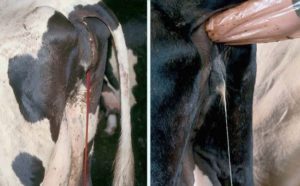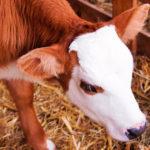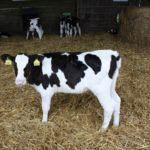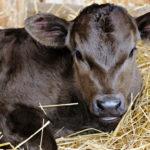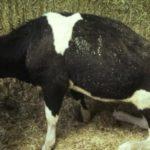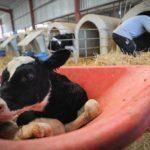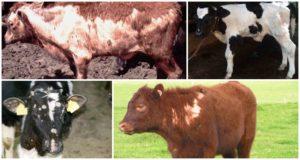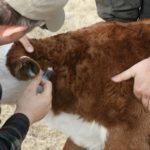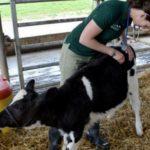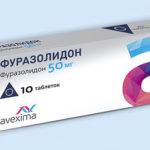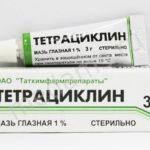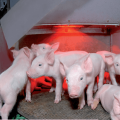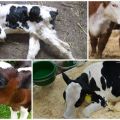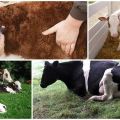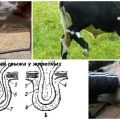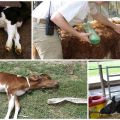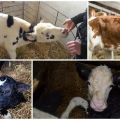Signs and who is the causative agent of colibacillosis in calves, treatment and prevention
Colibacillosis affects calves in the first few days after their birth - this is a serious disease of infectious etiology that requires immediate therapy. The causative agent of the pathology is Escherichia coli, which causes severe diarrhea, exhaustion, dehydration and general intoxication of the animal's body. Without timely treatment, a calf can die in a few days, and in a hyperacute form of the disease, in a few hours.
What is the disease
Colibacillosis has several more names - escherichiosis, colidiarrhea, colisepsis. Young animals are susceptible to the disease, starting from the first days of life. The most frequent route of infection is alimentary, less often an animal can become ill in utero or aerogenically. Calves are infected by contact with the pathogen:
- through infected objects;
- mother's colostrum and dishes from which the calf drinks milk;
- contaminated air;
- dirty hands of staff caring for the animals and clothing with bacteria on the surface;
- as a result of contact with rodents (mice, rats) - due to the instability of the body of newborn cattle before infections;
- in case of non-observance of sanitary standards for keeping livestock in the stall;
- due to violation of the rules of feeding, caring for adult cows and young animals during weaning.
The disease is a lesion of the intestine, in which the animal suddenly begins diarrhea, followed by dehydration. Pathology does not develop in young animals with strong immunity and full-fledged intestinal microflora, which resists the penetration of the E. coli mucosa.
If the balance of microflora is disturbed, the causative agent of the disease is introduced into the intestinal tissues and actively multiplies. As a result of the growth of a colony of pathogenic microorganisms, an inflammatory process is triggered. Poisoning with endotoxins (waste products of the pathogen) and the absence of phagocytosis are the main reasons for the severe clinical picture of colibacillosis.
Infectious agents
White diarrhea, or colibacillosis, develops in a calf when infected with the causative agent of colibacillosis - the pathogenic E. coli Escherichia coli. Refers to gram-negative sticks. It has rounded ends, reaches a size of 2 * 0.6 microns, does not form spores and capsules.
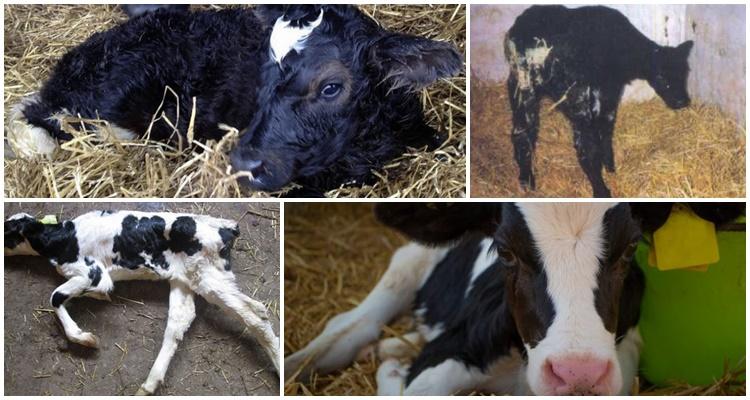
Escherichia calmly reproduce in their habitual nutrient medium - this is soil, manure, water, milk, surfaces of livestock buildings, cattle care items. Favorable conditions for the existence of the causative agent of colibacillosis - temperature 37 aboutC, RN 7.2-7.4, in which the bacillus can remain vital for up to two months.
Factors contributing to the occurrence of colibacillosis
Calves are at risk of contracting colibacillosis in the first 3-7 days after birth and in the post-weaning period. Outbreaks of pathology are noted at any time of the year, but more often in the winter and spring periods.
Factors predisposing to the disease:
- reduced resistance of the newborn's body to infectious diseases;
- lack of passive immunity in calves - ignoring feeding with colostrum containing antibodies to the causative agent of colibacillosis, which are produced in cows during routine vaccination with drugs containing serological variants of Escherichia coli;
- poorly developed barrier functions of the calf liver, high permeability of the intestinal walls;
- poor quality nutrition of pregnant cows;
- crowded stall keeping of livestock;
- violation of the optimal indicators of temperature and humidity in the barn.
The risk of infection of young animals in stalls increases, where compliance with sanitary and veterinary standards is ignored, mice and rats are bred.
What are the symptoms of the disease
There are three forms of colibacillosis:
- Septic. After the defeat of the intestine, the pathogen penetrates into the circulatory and lymphatic systems, internal organs. If the natural immunoglobulins in the calf's body are insufficient, the whole body becomes rapidly inflamed.
- Enteritic. It manifests itself when invaded viral forms enter the body. The accumulation of toxins leads to the formation of a large amount of fluid in the intestines and a sharp change in electrolyte balance.
- Enterotoxemic. Mixed form of the disease.
The incubation period of the disease is 1-2 hours to 3 days, depending on the body's resistance of the calf, nutritional conditions, maintenance and age. With untimely diagnosis and therapy, the mortality rate of the livestock can reach 60-70%.
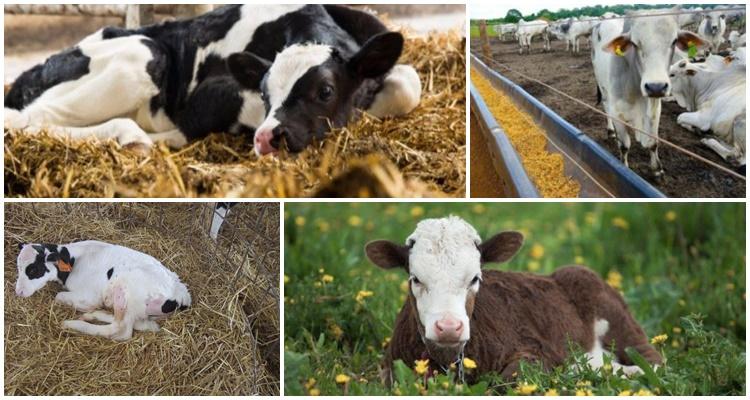
Subacute stage
Signs of the subacute stage:
- prolonged diarrhea;
- the content of mucus and blood in the feces;
- dehydration;
- retraction of the sides and eyelids.
More often the subacute stage proceeds in the enteric form.
Acute stage
In the acute stage of colibacillosis, signs of a septic form are most often manifested. At the onset of the disease, the calf's temperature rises by 0.5-1 aboutC, then the indicators decrease. Further, pronounced symptoms join:
- weakness;
- increased heart rate and breathing;
- undulating contractions of the body;
- diarrhea.
As a result of the release of a large amount of waste products of bacteria and the destruction of part of the colonies of the pathogen, septic shock occurs. It manifests itself as vascular collapse.
Hyperacute stage
In the hyperacute stage, the enterotoxemic form of colibacillosis is observed. All of the above symptoms are present, up to convulsions and the onset of severe coma. In most cases, therapy is meaningless, the animal dies after 2-3 days.
How is the disease diagnosed
Often, young calves suffer from salmonellosis, vibrio and viral diarrhea, diplococcal infections, therefore, differential diagnosis of colibacillosis is important. In addition to the clinical picture, the results of laboratory tests are evaluated.The feces of several infected animals are examined, in which the pathogen is sown. In the presence of dead cattle heads, the heart, head, liver, lymph nodes of the corpses are examined.
How to cure colibacillosis in cattle
An integrated approach is used in therapy - a combination of antibacterial drugs, immunoglobulins, detoxification of the body, adherence to a diet.
It is important to restore water-salt metabolism, remove toxins, and replenish the supply of carbohydrates and proteins in the animal's body.
Eliminate contagion
Treatment begins with isolating the sick animal. This is necessary to prevent disease in the entire livestock. The calf is put on a milk-free diet. It is important to disinfect the room in which the colibacillosis pathogen has multiplied.
Removal of intoxication
To eliminate the symptoms of intoxication, the animal is soldered with alkaline solutions to remove the decay products of the pathogen from the body. Apply droppers with saline, Trisol solution, glucose. The use of bacteriophages, hyperimmune Escherichiosis serum, antitoxic serum against colibacillosis and salmonellosis, gamma globulins will allow to avoid a lethal outcome.

Rehabilitation therapy
It is imperative to prescribe antibiotics, which are selected depending on the sensitivity of the pathogen:
- "Sulfazole";
- "Sulfadimethoxin";
- Enroxil;
- "Gentamicin";
- Furazolidone;
- "Levomycetin";
- "Tetracycline";
- Flumequin.
Antibiotics are given three times a day with water or colostrum, changing drugs in order to avoid the development of resistance to them of the pathogen. Combine antibacterial and antihistamines.
Symptomatic and general tonic agents
Symptomatic therapy has the following goals:
- restore water-salt metabolism;
- normalize the acid-base balance;
- neutralize the effect of toxins;
- compensate for the deficiency of vitamins and minerals.
Intramuscular injections of vitamin preparations, rehydration therapy with the "Regidron" solution, droppers of Orsol, Ringer-Locke are useful.
Prevention
To prevent the development of colibacillosis in a newborn calf, it is necessary to take care of preventive measures in time, including:
- routine vaccination with inactivated drugs - 4 weeks before cow mating (2 vaccinations with an interval of 14 days);
- timely vaccination of newborn cattle;
- observance of hygiene of childbirth, drinking milk;
- compliance with sanitary and hygienic standards by staff caring for livestock;
- keeping clean the equipment used in the care and feeding of animals;
- regular disinfection measures in the stall.
Preventive measures are not troublesome and costly, but help to minimize the time-consuming and not always successful treatment of colibacillosis in young animals.
Escherichia are sensitive to a solution of bleach at 3% concentration, 20% of fresh lime, a solution of sodium hydroxide in hot form at 4% concentration. This must be taken into account in the prevention of colibacillosis in calves in the form of regular disinfection of premises. Infected cattle require urgent treatment to avoid serious complications and death.
